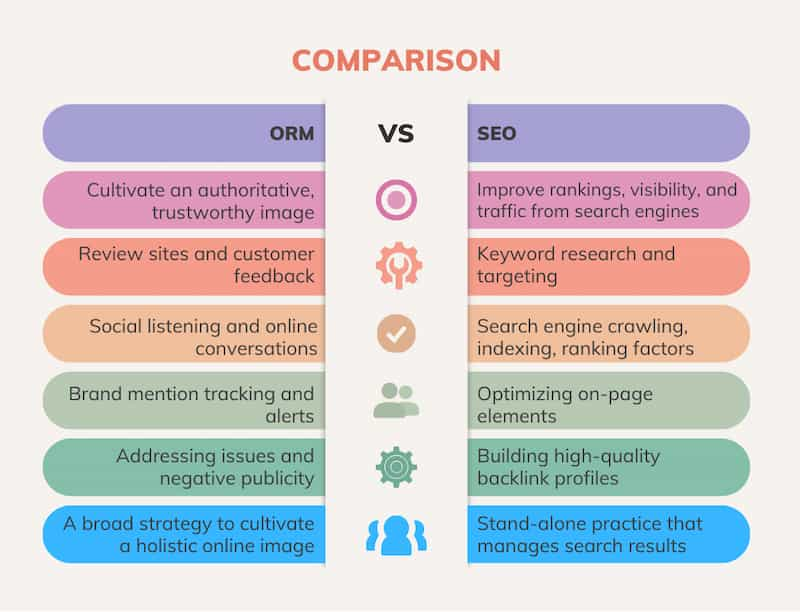How Search Engine Reputation Management is Different Than SEO

Online Reputation Management (ORM) and SEO (Search Engine Optimization) are both crucial for maintaining a strong online presence, but they serve distinct purposes.
SEO is a stand-alone practice that usually manages organic search results for a single website. ORM manages multiple websites, profiles, databases, wikis, review platforms, images, and much more.
Understanding the core distinctions allows brands to create more cohesive online success plans leveraging the strengths of both.
Key Takeaways
As any brand looks to build success through digital channels, understanding the differences between optimization for traffic and managing public perception is essential. Keeping SEO and ORM initiatives aligned while separating the core focuses will produce the best results.
Some key points include:
- SEO builds organic visibility and traffic. ORM manages a broader reputation
- Consumer research and reviews now make reputation vital
- All brands need holistic ORM monitoring and management
- When coordinated, SEO and ORM efforts will further amplify the impact
Sections
- The Difference: SEO and ORM
- Benefits of Online Reputation Management
- Key ORM Strategies
- Key Aspects of SEO
- When to Use Online Reputation Management (ORM)
- When to Use SEO
The Difference: SEO and ORM
The goal of SEO is to appear prominently on search engine results pages (SERPs) when people search for related topics and terms.
Key components of an SEO campaign include:
- Improving rankings, visibility, and traffic from search engines
- Optimizing on-page and off-page factors like keyword research, site indexing, metadata, content creation, backlinks, site speed, and performance
Online Reputation Management focuses more comprehensively on monitoring, managing, and building a brand’s credibility and public perception across the entirety of the online sphere.
This means addressing factors like:
- Customer feedback
- Review sites
- Social conversations
- Overall brand mentions
Now, let’s drill into the differences between SEO and ORM:
- Objective:
ORM: Focuses on shaping and maintaining a positive online image for brands or individuals. This involves managing reviews, addressing negative content, and promoting positive narratives across various digital platforms.
SEO: Primarily concerned with improving a website’s visibility in search engine results. This is achieved by optimizing website content and structure to rank higher for specific keywords.
- Scope:
ORM: Broad in scope, encompassing a variety of online platforms, including search engines, review sites, social media, forums, and more.
SEO: Primarily targets search engines, aiming to boost organic traffic to websites by improving rankings.
- Tactics:
ORM: Uses a combination of techniques like content creation, public relations, review management, negotiations, and even legal avenues when needed. SEO is just one of the tools in the ORM toolkit.
SEO: Employs specific strategies like keyword optimization, link-building, on-site optimization, and content creation tailored for search engine algorithms.
- Outcome:
ORM: A holistic online image where the negative content is suppressed and positive narratives are promoted, leading to better public perception and trust.
SEO: Higher visibility on search engines leading to increased website traffic, which can result in better engagement and conversions.
In essence, while ORM leverages SEO as one of its strategies, SEO on its own doesn’t necessarily address the broader aspects of a brand’s or individual’s complete online reputation.
Benefits of Online Reputation Management
Effective online reputation management offers a multitude of benefits:
- Trust and Credibility: A solid online reputation fosters trust. When people view a brand or individual in a positive light, they’re more likely to trust them.
- Financial Benefits: Positive online feedback, like high star ratings and good reviews, often means more business and higher profits.
- Attracting Top Talent: Respected brands naturally draw in skilled and dedicated individuals.
- Minimizing Risks: Following the “broken window theory,” a good reputation reduces potential problems or controversies.
- Handling Challenges: Brands that resonate with their audience’s values stand a stronger chance during challenging times. Consider the different public reactions towards companies like Apple Computer compared to Monsanto.
Prioritizing your brand’s online reputation is a smart move for CEOs, marketing specialists, and professionals alike. It’s more than just a strategy—it’s a cornerstone for long-term success.
Here are some key facts about online reputation management:
- 85% of consumers trust online reviews as much as personal recommendations.
- Nearly 3 out of 4 consumers trust a company more if it has positive reviews.
- 60% of consumers say that negative reviews made them not want to use a business.
Key ORM Strategies
Online Reputation Management (ORM) is a comprehensive approach to sculpting a brand’s digital image. To effectively manage and improve an online reputation, organizations often employ a blend of diverse strategies:
- Content Creation & Management:
Positive Content Promotion: Generate and promote positive content across various platforms like blogs, websites, and social media channels.
Regular Content Updates: Keep websites and social media profiles fresh and relevant to showcase current achievements, events, and updates.
- Search Engine Optimization (SEO):
Positive Content Boosting: Ensure that positive news, articles, and web pages rank higher in search engine results.
Suppress Negative Content: Use SEO to push down negative or unfavorable content in search results.
- Review Management:
Monitor & Respond: Keep an eye on reviews across various platforms and respond promptly, especially to negative feedback.
Encourage Reviews: Request satisfied customers or clients to leave positive reviews to boost the overall rating.
- Social Media Management:
Active Engagement: Regularly post, respond to comments, and engage with the audience to create a positive and interactive brand image.
Handle Criticism: Address negative comments or concerns diplomatically and professionally.
- Public Relations & Media Outreach:
Press Releases: Disseminate positive news and announcements to the media.
Manage Negative Publicity: Work proactively with media outlets to address or correct misinformation.
- Negotiation & Legal Channels:
Remove Defamatory Content: Engage in discussions or negotiations with platforms or individuals to remove false or defamatory content.
Legal Action: As a last resort, consider legal avenues to address particularly damaging or false information.
- Transparency & Authenticity:
Open Communication: Keep communication channels open and be honest about mistakes or issues.
Build Trust: Show authentic efforts in rectifying mistakes and adhere to promises.
Key Aspects of SEO
- On-site Optimization:
On-site optimization, also known as on-page SEO, refers to the practice of optimizing elements within a website to improve its visibility in search engine rankings. This encompasses various factors including, but not limited to, refining the content quality, enhancing meta descriptions and title tags, ensuring mobile-friendliness, optimizing site speed, utilizing appropriate header tags, and structuring internal links. These adjustments are made directly on the webpage, ensuring that the site is both user-friendly and search engine-friendly, ultimately aiming for better search visibility and higher organic traffic. - SEO Optimized Content:
SEO-optimized content is crafted with both the user and search engines in mind. It involves creating high-quality, relevant, and informative content that naturally incorporates targeted keywords and phrases. This approach not only ensures that the content is valuable and engaging to readers but also increases its visibility in search engine results, leading to higher organic traffic and improved website performance. - Link-building & Offsite Optimization:
Link building and off-site optimization are vital components of SEO that focus on enhancing a website’s authority and relevance through external means. This strategy involves acquiring backlinks from reputable and relevant external websites, signaling to search engines that the content is credible and valuable. High-quality, organically obtained backlinks are especially prized as they vouch for the authenticity and significance of the linked content. Off-site optimization goes beyond just link building, encompassing strategies like social media engagement, brand mentions, and influencer outreach, all of which collectively bolster a website’s standing in search engine rankings.
When to Use Online Reputation Management (ORM)
Companies should prioritize online reputation management (ORM) when aiming to proactively shape public perception and amplify positive brand associations.
Deliberate ORM is especially vital for:
Recovering from Issues
If a business has faced PR crises, negative reviews, customer conflicts or other reputation-damaging events, ORM is necessary for damage control and narrative correction. Strategic reputation rebuilding restores trust and credibility.
Entering New Markets
For brands expanding into new regions or customer segments, tight control of what potential consumers encounter online is imperative. ORM ensures positioning aligns with new markets and that first impressions drive growth.
Ongoing Management
As online reviews and social conversations continuously evolve, constant ORM monitoring allows brands to respond quickly to emerging issues and capitalize on positive feedback. Remaining hands-on preserves hard-won reputation gains.
While search engine optimization focuses on increasing discoverability and website traffic, holistic ORM works continuously in the background to direct what audiences see when attention has been captured.
For any business today, ORM should become an always-on priority integrated into strategy, not just a fix when problems occur. Being perpetually proactive with public perception management allows brands to shape narratives on their terms.
When to Use SEO
Search engine optimization (SEO) should be a foundational investment for any business with an online presence aiming to amplify visibility and website traffic.
However, companies experience the greatest SEO impact and ROI by focusing efforts around:
New Website Launches
Relevant SEO built into new website development ensures high organic rankings right from launch. Authoritative domains start attracting search traffic quickly.
Emerging Products or Services
Optimizing pages and content focused on new offerings helps them stand out quickly in SERPs rather than getting lost amongst existing materials.
Increased Market Share
SEO enables brands to target and rank for previously untapped keywords reaching new customer segments first. Competitive conquesting leverages optimization.
Website Traffic Growth
Companies looking to scale qualified organic traffic over the long-term need comprehensive, evolving SEO strategies driving incremental but consistent gains.
Overall, SEO should become engrained in any maturing website’s DNA through ongoing enhancement. But honing in on key launches, emerging projects and traffic growth goals allows brands to pinpoint where SEO can have an immediate, noticeable impact on the bottom line.
The most essential times to double down on optimization investment are when increased visibility converts directly into tangible business results.
Balancing Both Approaches
While ORM and SEO have distinct objectives, they often overlap, and their strategies can complement one another. For instance, a company seeking to mend its online reputation might use SEO tactics to push positive content to the forefront of search results.
Conversely, a strong online reputation can bolster SEO efforts, as trustworthiness can influence user behavior and, indirectly, search engine rankings.
Ideally, businesses should adopt a holistic approach, integrating both ORM and SEO strategies to ensure they not only rank high on search engines but also convey a positive brand image consistently.
About the author
Kent Campbell is the chief strategist for Reputation X, an award-winning online reputation management agency. He has over 15 years of experience with SEO, Wikipedia editing, review management, and online reputation strategy. Kent has helped celebrities, leaders, executives, and marketing professionals improve the way they are seen online. Kent writes about reputation, SEO, Wikipedia, and PR-related topics, and is an expert witness for reputation-related legal matters.
–
Tags: Online Reputation Management, Reputation Management, SEO.

